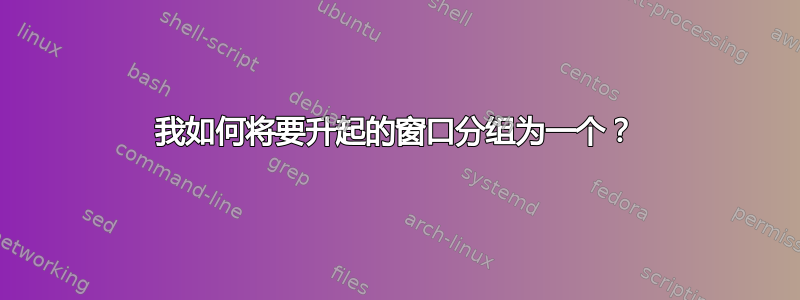
我有两个窗口,A 和 B。是否可以以某种方式将两个窗口链接在一起,使得切换到 A 时也会引发 B,或者切换到 B 时也会引发 A?
我知道使用多个工作区是一种替代选择,但想知道这是否也可行?
答案1
介绍
以下脚本允许选择两个窗口,当两个窗口都打开时,当用户聚焦其中一个窗口时,它将同时提升两个窗口。例如,如果一个链接窗口 A 和 B,切换到 A 或 B 将使两个窗口都提升到其他窗口之上。
要停止脚本,您可以killall link_windows.py在终端中使用,或关闭并重新打开其中一个窗口。您也可以通过X按任一窗口选择弹出对话框中的关闭按钮来取消执行。
潜在的调整:
- 可以使用脚本的多个实例来对两个窗口进行分组。例如,如果我们有窗口 A、B、C 和 D,我们可以将 A 和 B 链接在一起,将 C 和 D 链接在一起。
- 可以将多个窗口分组到一个窗口下。例如,如果我将窗口 B 链接到 A,将窗口 C 链接到 A,将窗口 D 链接到 A,这意味着如果我总是切换到 A,我可以同时调出所有 4 个窗口。
用法
运行脚本如下:
python link_windows.py
该脚本与 Python 3 兼容,因此也可以作为
python3 link_windows.py
有两个命令行选项:
--quiet或-q,允许关闭 GUI 窗口。使用此选项,您只需用鼠标单击任意两个窗口,脚本就会开始链接它们。--help或-h,打印使用情况和描述信息。
该-h选项产生以下信息:
$ python3 link_windows.py -h
usage: link_windows.py [-h] [--quiet]
Linker for two X11 windows.Allows raising two user selected windows together
optional arguments:
-h, --help show this help message and exit
-q, --quiet Blocks GUI dialogs.
可以通过 查看更多技术信息pydoc ./link_windows.py,其中./表示您必须与脚本位于同一目录中。
两个窗口的简单使用流程:
会出现一个弹出窗口,要求您选择窗口 #1,按OK或点击Enter。鼠标指针将变成十字形。单击您要链接的窗口之一。
会出现第二个弹出窗口,要求您选择窗口 #2,按下OK或点击Enter。再次,鼠标指针将变成十字形。单击要链接的另一个窗口。之后将开始执行。
每当您聚焦任一窗口时,脚本都会将另一个窗口升起,但将焦点返回到最初选择的窗口(注意 - 为了获得最佳性能,需要四分之一秒的延迟),从而产生窗口链接在一起的感觉。
如果两次选择同一个窗口,脚本将退出。如果在任何时候单击弹出对话框的关闭按钮,脚本将退出。
脚本源
也可作为GitHub 要点
#!/usr/bin/env python
# -*- coding: utf-8 -*-
"""
Author: Sergiy Kolodyazhnyy
Date: August 2nd, 2016
Written for: https://askubuntu.com/q/805515/295286
Tested on Ubuntu 16.04 LTS
"""
import gi
gi.require_version('Gdk', '3.0')
gi.require_version('Gtk', '3.0')
from gi.repository import Gdk, Gtk
import time
import subprocess
import sys
import argparse
def run_cmd(cmdlist):
""" Reusable function for running shell commands"""
try:
stdout = subprocess.check_output(cmdlist)
except subprocess.CalledProcessError:
sys.exit(1)
else:
if stdout:
return stdout
def focus_windows_in_order(first, second, scr):
"""Raise two user-defined windows above others.
Takes two XID integers and screen object.
Window with first XID will have the focus"""
first_obj = None
second_obj = None
for window in scr.get_window_stack():
if window.get_xid() == first:
first_obj = window
if window.get_xid() == second:
second_obj = window
# When this function is called first_obj is alread
# raised. Therefore we must raise second one, and switch
# back to first
second_obj.focus(int(time.time()))
second_obj.get_update_area()
# time.sleep(0.25)
first_obj.focus(int(time.time()))
first_obj.get_update_area()
def get_user_window():
"""Select two windows via mouse. Returns integer value of window's id"""
window_id = None
while not window_id:
for line in run_cmd(['xwininfo', '-int']).decode().split('\n'):
if 'Window id:' in line:
window_id = line.split()[3]
return int(window_id)
def main():
""" Main function. This is where polling for window stack is done"""
# Parse command line arguments
arg_parser = argparse.ArgumentParser(
description="""Linker for two X11 windows.Allows raising """ +
"""two user selected windows together""")
arg_parser.add_argument(
'-q','--quiet', action='store_true',
help='Blocks GUI dialogs.',
required=False)
args = arg_parser.parse_args()
# Obtain list of two user windows
user_windows = [None, None]
if not args.quiet:
run_cmd(['zenity', '--info', '--text="select first window"'])
user_windows[0] = get_user_window()
if not args.quiet:
run_cmd(['zenity', '--info', '--text="select second window"'])
user_windows[1] = get_user_window()
if user_windows[0] == user_windows[1]:
run_cmd(
['zenity', '--error', '--text="Same window selected. Exiting"'])
sys.exit(1)
screen = Gdk.Screen.get_default()
flag = False
# begin watching for changes in window stack
while True:
window_stack = [window.get_xid()
for window in screen.get_window_stack()]
if user_windows[0] in window_stack and user_windows[1] in window_stack:
active_xid = screen.get_active_window().get_xid()
if active_xid not in user_windows:
flag = True
if flag and active_xid == user_windows[0]:
focus_windows_in_order(
user_windows[0], user_windows[1], screen)
flag = False
elif flag and active_xid == user_windows[1]:
focus_windows_in_order(
user_windows[1], user_windows[0], screen)
flag = False
else:
break
time.sleep(0.15)
if __name__ == "__main__":
main()
笔记:
- 从命令行运行时,弹出对话框会产生以下消息:
Gtk-Message: GtkDialog mapped without a transient parent. This is discouraged.可以忽略这些消息。 - 咨询如何在 Unity 中手动编辑/创建新的启动器项?为该脚本创建启动器或桌面快捷方式,以便双击启动它
- 为了将此脚本链接到键盘快捷键以方便访问,请查阅 如何添加键盘快捷键?
答案2
将任意数量的窗口作为一个窗口
以下解决方案将让您选择任何使用键盘快捷键将两个、三个或多个窗口组合并作为一个窗口显示。
该脚本通过三个参数完成其工作:
add
将活动窗口添加到组
raise
提高设定组
clear
清除组,准备定义新组
剧本
#!/usr/bin/env python3
import sys
import os
import subprocess
wlist = os.path.join(os.environ["HOME"], ".windowlist")
arg = sys.argv[1]
if arg == "add":
active = subprocess.check_output([
"xdotool", "getactivewindow"
]).decode("utf-8").strip()
try:
currlist = open(wlist).read()
except FileNotFoundError:
currlist = []
if not active in currlist:
open(wlist, "a").write(active + "\n")
elif arg == "raise":
group = [w.strip() for w in open(wlist).readlines()]
[subprocess.call(["wmctrl", "-ia", w]) for w in group]
elif arg == "clear":
os.remove(wlist)
如何使用
该脚本
wmctrl需要xdotool:sudo apt-get install wmctrl xdotool- 将上述脚本复制到一个空文件中,另存为
groupwindows.py 测试运行脚本:打开两个终端窗口,运行命令:
python3 /absolute/path/to/groupwindows.py add在两个窗口中都打开。用其他窗口覆盖它们(或最小化它们)。打开第三个终端窗口,运行以下命令:
python3 /absolute/path/to/groupwindows.py raise前两个窗口将会合二为一。
如果一切正常,请创建三个自定义快捷键:选择:系统设置 > “键盘” > “快捷键” > “自定义快捷键”。单击“+”并将以下命令添加到三个单独的快捷键中:
在我的系统上,我使用:
Alt+ A,运行命令:
python3 /absolute/path/to/groupwindows.py add...将窗口添加到组。
Alt+ R,运行命令:
python3 /absolute/path/to/groupwindows.py raise...来提高群体。
Alt+ C,运行命令:
python3 /absolute/path/to/groupwindows.py clear...清除群组
解释
该脚本的工作原理很简单:
- 当使用参数运行时
add,脚本会将活动窗口的窗口 ID 存储/添加到隐藏文件中~/.windowlist 当使用参数运行时
raise,脚本读取文件,使用以下命令调出列表中的窗口:wmctrl -ia <window_id>- 当使用该参数运行时
clear,脚本将删除隐藏文件~/.windowlist。
笔记
- 该脚本也将在最小化的窗口上运行,它将取消最小化可能最小化的窗口
- 如果窗口集位于另一个视口上,则脚本将切换到相应的视口
- 该集合是灵活的,您可以随时将其他窗口添加到当前集合中。
更加灵活?
如上所述,上面的脚本允许随时将窗口添加到分组窗口中。下面的版本还允许移除分组列表中的任何窗口(随时):
#!/usr/bin/env python3
import sys
import os
import subprocess
wlist = os.path.join(os.environ["HOME"], ".windowlist")
arg = sys.argv[1]
# add windows to the group
if arg == "add":
active = subprocess.check_output([
"xdotool", "getactivewindow"
]).decode("utf-8").strip()
try:
currlist = open(wlist).read()
except FileNotFoundError:
currlist = []
if not active in currlist:
open(wlist, "a").write(active + "\n")
# delete window from the group
if arg == "delete":
try:
currlist = [w.strip() for w in open(wlist).readlines()]
except FileNotFoundError:
pass
else:
currlist.remove(subprocess.check_output([
"xdotool", "getactivewindow"]).decode("utf-8").strip())
open(wlist, "w").write("\n".join(currlist)+"\n")
# raise the grouped windows
elif arg == "raise":
group = [w.strip() for w in open(wlist).readlines()]
[subprocess.call(["wmctrl", "-ia", w]) for w in group]
# clear the grouped window list
elif arg == "clear":
os.remove(wlist)
运行脚本的附加参数是delete,因此:
python3 /absolute/path/to/groupwindows.py delete
从分组窗口中删除活动窗口。要运行此命令,在我的系统上,我将Alt+设置D为快捷方式。


